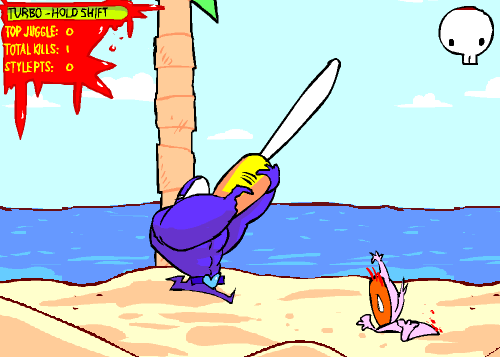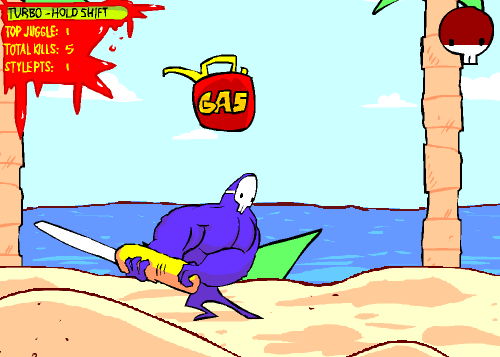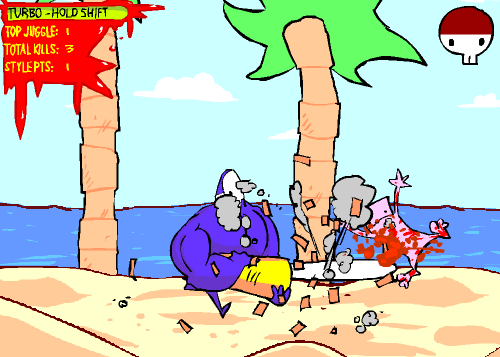Retro Replay Review
Gameplay
Chainsaw the Children delivers a straightforward yet intense side-scrolling action experience. You control the burly, hockey-masked father—familiar from Dad ’n Me—using the arrow keys to navigate left or right across a single-screen stage. The “A” button provides dual functionality: a quick tap swings the chainsaw in a devastating arc, while holding it down sustains the saw blade in place for continuous damage. Coupled with the “Shift” key to sprint, the control scheme feels both accessible to newcomers and satisfying for seasoned players seeking precise inputs.
(HEY YOU!! We hope you enjoy! We try not to run ads. So basically, this is a very expensive hobby running this site. Please consider joining us for updates, forums, and more. Network w/ us to make some cash or friends while retro gaming, and you can win some free retro games for posting. Okay, carry on 👍)
The central loop revolves around hunting down small purple flat-head creatures—representing the “children”—and dispatching them in increasingly creative ways. You can decapitate foes with swift slashes or juggle them mid-air by timing your chainsaw swings just right. This juggling mechanic adds a layer of arcade-style flair, rewarding players who string together combos with style points. Although the game tracks kills, juggles, and your evolving style meter in real time, it deliberately eschews post-stage scoreboards, emphasizing the immediacy of action rather than leaderboard bragging rights.
Time management injects an extra dimension of tension. A white skull icon in the upper right corner serves as your timer, steadily ticking down as you carve through waves of enemies. Scouring the environment for hidden gas cans—often tucked behind destructible palm trees—extends your play session, forcing you to balance aggression with exploration. This simple but effective design choice keeps each run feeling urgent, ensuring you’re never quite sure if you can finish the stage before your remaining fuel runs dry.
Difficulty ramps up quickly, introducing denser enemy formations and more aggressive AI patterns in later levels. While early stages function as tutorials for mastering basic combos and gas-can hunts, subsequent stages test your ability to juggle multiple axes of challenge: maintaining combos, conserving time, and sidestepping enemy projectiles. Though there’s no formal checkpoint system, the game’s short, single-screen levels keep frustration low—death means a quick restart, and you’ll often find yourself eager to try just one more run to break your previous combo record.
Graphics
Visually, Chainsaw the Children shines with hand-drawn graphics by Dan Paladin, whose distinctive art style first captured players’ imaginations in Dad ’n Me. Each sprite exudes a quirky, cartoonish menace: the hulking dad’s muscles ripple in exaggerated strokes, while the purple flat-head “children” wobble in expressive loops that make every decapitation feel both gruesome and oddly playful. The color palette leans into bold primaries, ensuring characters pop against the relatively muted background scenery.
Paladin’s flair for macabre humor is evident in every frame. Overgrown palm trees shudder when you rev your chainsaw in front of them, and gory particle effects accompany each successful kill, splattering pixelated blood in an almost celebratory shower. Despite its retro-inspired pixelation, the game never feels outdated; rather, it uses its old-school roots to craft an aesthetic that’s immediate, memorable, and unique among indie action titles.
Environmental details—like the rusted metal shacks and crumbling wooden docks—add depth to what might otherwise be a purely arena-style stage. Each backdrop is rich with visual gags and hidden flourishes, from graffiti tags on warehouse walls to innocuous items (like tossed soda cans) that shatter satisfyingly under your chainsaw’s teeth. This attention to background detail elevates the sense that you’re exploring a lovingly realized microcosm, even within a single-screen level design.
Animations run smoothly even when the screen is crowded with enemies and particle effects. The game maintains a consistent frame rate, ensuring that your inputs—especially critical for juggling combos—never feel unresponsive. Overall, the graphics do more than just look good; they enhance the gameplay’s visceral impact, making each chainsaw rev and enemy splatter feel weighty and exhilarating.
Story
Chainsaw the Children embraces minimal narrative structure, much like its predecessor. There’s no elaborate cutscene sequence or lengthy exposition—your mission is clear from the outset: a hockey-masked dad on a mission to hunt down “children,” as bizarre as that premise may sound. This stripped-down approach keeps the focus firmly on the action, channeling the spirit of classic arcade beat-’em-ups.
However, within its sparse storyline lies a tongue-in-cheek critique of patriarchal authority and absurdist violence. The very image of a musclebound father tearing through tropically themed backdrops with a roaring chainsaw is as much satire as it is spectacle. Fans of Dan Paladin’s previous work will recognize the same dark humor and subversion of familiar tropes—here, the protector archetype is twisted into an over-the-top execution machine.
For players seeking lore or character development, the game offers subtle hints rather than explicit storytelling. Background elements—tattered posters, broken toys, and graffiti—serve as environmental storytelling devices, hinting at a surreal world where fatherly love takes a very extreme form. While a dedicated story mode might have broadened its narrative appeal, the deliberate brevity works in Chainsaw the Children’s favor, ensuring you spend more time revving your saw than reading dialogue boxes.
Overall Experience
Chainsaw the Children stands out as a tightly focused indie action game that delivers high replay value through its combo-driven mechanics and time-pressure gameplay. Each playthrough lasts only a few minutes, but the urge to improve—whether by achieving longer juggle chains or uncovering hidden gas can placements—keeps you coming back for more. The absence of post-game score screens places the emphasis on the thrill of the moment, rather than cold numbers, which many players will appreciate.
People who enjoyed the manic pace of early arcade titles or the distinctive art style of Dad ’n Me will find much to love here. Chainsaw the Children strikes a rare balance between brutality and whimsy: it’s gory but never gratuitously grotesque, funny without undermining its edge. The learning curve is approachable, yet mastering the timing for extended combos feels rewarding, offering a satisfying challenge for perfectionists.
While the lack of a formal progression system or narrative campaign might deter players seeking a grand, multi-hour adventure, Chainsaw the Children embraces its short-burst structure wholeheartedly. It’s an ideal pick-up-and-play title for quick sessions, party gatherings, or those moments when you crave a pure adrenaline rush without the baggage of sprawling systems. In sum, this game is a lean, mean, chainsaw-wielding spectacle that showcases Dan Paladin’s art and the quirky charm of indie action design.
For anyone intrigued by hand-drawn graphics, offbeat humor, and fast-paced combos, Chainsaw the Children is a must-try. Its brief stages and simple controls belie a surprising depth of strategy, particularly once you start chasing high-combo runs and efficient gas-can hunts. If you’re ready to rev up a chainsaw, chase down bizarre foes, and revel in cartoon carnage, this title delivers an experience unlike any other on the indie scene.
 Retro Replay Retro Replay gaming reviews, news, emulation, geek stuff and more!
Retro Replay Retro Replay gaming reviews, news, emulation, geek stuff and more!









Reviews
There are no reviews yet.